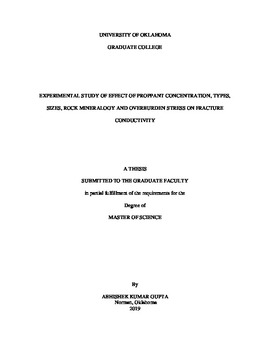| dc.description.abstract | Hydrocarbon production from unconventional reservoirs, particularly shales, requires massive hydraulic fractures to expose the large surface areas within the formation and provide a conduit to the wellbore. Proppants are pumped along with the fracturing fluids during hydraulic fracturing to keep the fractures open. For the economic production of hydrocarbon, maintaining the conductivity of such fractures is critical. However, there are different mechanisms such as proppant crushing, fines migration, proppant embedment and proppant diagenesis etc., which can lead to the significant reduction in fracture conductivity with time. The severity of each mechanisms varies substantially depending on the rock mineralogy, proppant type, proppant concentration, proppant size and overburden stress. Field observations reveals the overall performance of well productivity depends on fracture conductivity which is influenced by the combination of these factors. Lab experiments conducted under simulated reservoir conditions can help to systematically evaluate the effect of different parameters on fracture conductivity. This study focuses on the effect of proppant concentration, proppant type, proppant size, rock mineralogy and overburden stress on the propped fracture conductivity under simulated reservoir conditions. Different damage mechanisms including proppant crushing, embedment and diagenesis and their severity to the conductivity reduction have also been evaluated.
Experiments were conducted with shale platens machined from Eagle Ford and Meramec formations. Proppants with different concentration (varying form 1.5 lb/ft2 to 4 lb/ft2), different sizes (20/40, 40/70, 60/100), different types were placed between the two platens and propped fracture conductivity is measured over the period of 7-60 days. Axial stress of 5000 psi was applied to simulate the closure stress which was also varied from 1500 to 7500 psi in different experiments to evaluate the effect of overburden stress on conductivity. The brine composed of 3% NaCl, 0.5% KCl was flowed at a constant rate of 3 ml/min throughout the experiment. In some experiments, 0.05 molar Na2CO3 was added to raise the pH of the brine up to 10.
Testing was done to study the effect of proppant concentration using 60/100 mesh Ottawa sand placed between metal platens; result shows significant reduction in permeability at lower concentration of 2 lb/ft2 compared to higher concentration of 4 lb/ft2. Within a unit drop in porosity, permeability declines up to 98% with 2 lb/ft2 concentration while conductivity decline of 80% and 60% observed with increased concentration of 3 lb/ft2 and 4 lb/ft2 respectively. Particle sizes analysis showed 13% fines generation at lower concentration compared to 8% at higher concentration.
Effect of particle size evaluated at different closure stress by placing the Ottawa sand (20/40 and 60/100 mesh) between metal platens shows higher crushing and proppant width reduction with higher stress. However, finer mesh (60/100) mesh shows relatively higher compaction and crushing compared to coarser sand (20/40) at each compaction pressure. Effect of particle size on conductivity evaluated using long term flow through conductivity tests with Meramec formation platens shows higher decline in conductivity with finer (60/100 mesh) sand compared to coarser (20/40 mesh sand). Compaction up to 17% observed with 20/40 sand compared to 25% compaction with 60/100 sand over the flow period of 10 days.
Experiments with different types of proppant shows higher initial permeability with ceramic proppant compared to Ottawa sand under similar conditions. Over the period of 8 days, experiment with Ottawa sand shows up to 60% fracture width reduction compared to 30% with ceramic proppant. Ceramic proppant also shows uniform distribution of embedded grains and formation extrusion. However, significant diagenetic growth is observed with ceramic proppant.
Over the life of a well, due to the production, pore pressure decreases leading to increase in effective stress on fractures. To study the effects of different stress condition on conductivity, experiments were conducted at 1500, 3000 and 7500 psi closure stress keeping all other test conditions the same. Conductivity was observed to decrease significantly at higher stress. Over the flow period of 10 days, fracture width reduces up to 50% at 7500 psi whereas up to 18% and 21% fracture width reduction observed at 1500 and 3000 psi respectively. Surface scans and SEM images shows higher degree of proppant crushing and embedment with increased closure stress. Exit brine composition also shows higher silica concentration at 7500 psi throughout the period of experiment indicating significant proppant crushing and dissolution.
Experiments with different rocks machined form Meramec, Vaca Muerta and Eagle Ford suggests higher decline in conductivity with higher clay and lower quartz content formations. Assuming the matrix permeability of (50 nd) and fracture half-length (100 ft), the dimensionless fracture conductivity (FCD) observed to decline at a very high rate and goes below 20 after 18 days in Eagle Ford, 35 days in Vaca Muerta and 75 days in Meramec. | en_US |
